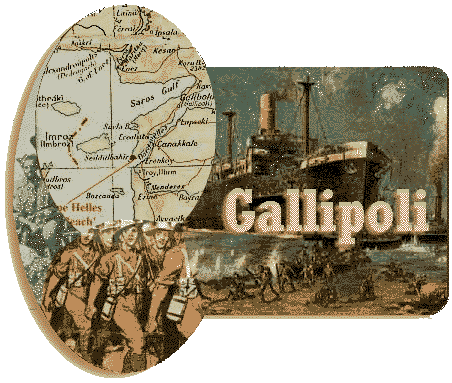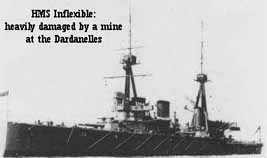

|
And the band played "Waltzing Matilda", How well I remember that terrible day, And the band played "Waltzing Matilda", Now those who were living did our best to survive, And no more I'll go "Waltzing Matilda", � |
� is the spot where an era ended and where the heart of a nation beats Mehmet Akif Ersoy, Turkish poet inscription on Turkish war memorial at Gallipoli � � � �The reasons for trying to force open that narrow strip of water that
separates Europe from Asia Minor were, on the surface, very simple. The
bloody impasse on the western front had led some to seek solutions elsewhere
and the war against the Turks seemed to offer one. The scenario went something
like this. The Royal Navy with Nelsonian daring would blast its way through
the Dardanelles, the Sea of Marmara and then the Narrows reducing the defending
forts to rubble as it went. Then, anchoring in the shadow of Constantinople,
its sheer presence would lead to revolution in Turkey and cow the Turkish
government into surrender. The flank of Germany and Austria-Hungary would
be exposed and with the sealanes to the Black Sea open, Russia could be
supplied with much-needed munitions. Newly rejuvenated, her massive
armies would steamroller westward into Berlin. If it had only been so.
 � � � �They generals thought they could do the job in three days. Land on the Gallipoli peninsula, clear it of Turks
and disable the seaward defences. With a bit of luck it could all be accomplished in 72 hours. They failed
too, and at a much greater cost in lives than the naval assault. For 259 days, from April 1915 to January
1916, the allied forces hung on to their toeholds on Gallipoli. A total of about 500,000 men were landed
there over the course of the campaign and almost 300,000 of them became casualties. For the Turks it was a
great victory and marked the time they successfully stood against the greatest empire the world had ever
seen. It threw up Mustapha Kemal, an obscure divisional commander, and propelled him on the road that
would lead him to become the �Father of the Nation�E For the Australians it would provide the sacrifice that
tempered their newly-forged nation in blood. For the British it was just another fiasco in a war full of them.
� � � � After the failure of the naval attempt to force the Dardanelles, it was decided to land
ground troops at the tip of the Gallipoli peninsula, secure the central heights and
destroy the Turkish batteries, thus opening the way for the navy to proceed up to
Constantinople. The force was commanded by General Ian Hamilton, a Scotsman
and a brave, experienced soldier. Its main constituents were the British 29th Division,
the 1st Royal Naval Infantry Division, the French 1st Infantry Division, the 29th Indian
Infantry Brigade and the Australia New Zealand Army Corps (ANZAC). There were
lesser contingents from many different parts of the British empire including the
colorfully named Assyrian Jewish Refugee Mule Corps. Formed in Egypt, they were
reputed to be the first Jewish unit to go into combat since the Romans took Jerusalem
in AD 70.
� � � �The peninsula never came anywhere near being cleared of Turks. The British managed to
gain the whole tip of the peninsula but they never pushed more than five miles inland. The
ANZACS didn�t do much better and though they fought with great skill and courage they
got little further than the heights overlooking the beaches, and never reached the crests.
For the first month the fleet had stayed offshore giving supporting shellfire and as the
battlefronts were so shallow the sea and its great ships were almost always in sight of the
men fighting on land. That changed on May 25th when a German U-boat torpedoed HMS
Triumph. The ships were withdrawn to the safety of the Greek islands and the soldiers
were left alone.
� � � �As spring gave way to a blistering summer and then a wet, weary winter conditions rapidly deteriorated. �The beautiful battalions of April 25th are wasted skeletons.�Ewrote Hamilton. Disease was rife, the soldiers filthy, rotting corpses lay everywhere and day after day the attacks and counter-attacks continued in a horrific parody of the trench warfare going on in France. By the end of the year the Turks were at breaking -point, but so were the British. Lord Kitchener came out from London to appraise the situation and was appalled at the mess he found. An atmosphere of gloom and desperation hung all over the peninsula and Kitchener recommended withdrawal. Slowly the troops were taken off, and in a brilliant last phase the rearguards were withdrawn without the Turks having the slightest idea what was happening. When the Turks woke up on January 9th, they found themselves alone on the peninsula and the British positions eerily empty. In a predictable display of military optimism, the evacuation was portrayed as a great victory, another example of the British genius for amphibious warfare. The public probably weren�t fooled and the soldiers definitely not. As one of the last Australian units slipped through the darkness down to the beach and the evacuation boats, one of the men was heard to whisper as he pointed to the graves of his fallen comrades,�I hope they don�t hear us go.�E Gallipoli : a footnote. I recently received an e-mail from a Turkish gentleman chiding me for disregarding the sufferings of the Turkish soldiers during the Gallipoli campaign. He was right, of course, and I feel I should add something here. The British Empire and Dominion troops who fought at Gallipoli laboured under terrible conditions but for their enemy things were, if anything, even worse. the Turkish army had no great fleet to supply it and as British submarines were active in the Sea of Marmora seaborne supply was not an option. A single railway line led to the peninsula but it ran out far from the battlefronts and had nowhere near the capacity to adequately service the Turkish army fighting there. Sometimes the Turkish troops were starving and it is said they would lick the traces of sauce they found inside cans of food discarded by the British and Anzac troops. And yet they held on and finally drove the invaders back onto their ships. The Turkish soldier was poorly equipped and often badly led but his courage and determination won the admiration of his foes. Before the landings the Anzacs were just as racist as most Europeans at that time and felt that the upcoming battle against a bunch of �asiatics�Ewould soon be successfully completed. Such ideas didn�t last long and a respect for their enemy grew amongst the Anzacs. They called the Turkish soldiers �Johnnie Turk�Eor �Mehmet�Eand these were terms not derogatory but akin to the name �Tommy�Ethat the Germans used to describe the British. After Gallipoli the Turkish army went on to other victories. In Mesopotamia a Britsh army was forced to surrender at Kut al Amara and though the British finally took Baghdad, Jerusalem and Damascus it took them three long years and massive superiority before they could do so. Even when the Great War itself ended the Turks had to struggle on: first to throw off the shackles of an unfair peace settlement, then to expel the invading Greek army and finally to face down the British Empire once again in the Chanak Crisis. In the early 1950�s Turkish troops fought alongside their former British and Australian enemies in the Korean conlict and throughout the long years of Cold War tension Turkey stood guard on NATO�s vulnerable southern flank. Political alignments change, enemies become friends, old soldiers fade away and life goes on. Perhaps at the end of the day the only real comrades-in-arms are the dead. On the overgrown, silent battlefields of Gallipoli may they rest in peace - together. |